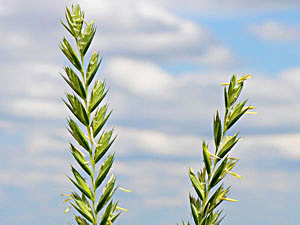
medicinal herbs
Couch Grass
Elytrigia repens

Herb: Couch Grass
Latin name: Elytrigia repens
Synonyms: Agropyron repens, Elymus repens, Triticum repens
Family: Gramineae (Grass Family)
Medicinal use of Couch Grass:
Couch grass is of considerable value as a herbal medicine, the roots being very useful in the treatment of a wide range of kidney, liver and urinary disorders. They have a gentle remedial effect which is well-tolerated by the body and has no side-effects. This plant is also a favourite medicine of domestic cats and dogs, who will often eat quite large quantities of the leaves. The roots are antiphlogistic, aperient, demulcent, diuretic, emollient, lithontripic and tonic. They are harvested in the spring and can be dried for later use. A tea made from the roots is used in cases of urinary incompetence and as a worm expellent. It is also an effective treatment for urinary tract infections such as cystitis and urethritis. It both protects the urinary tubules against infections and irritants, and increases the volume of urine thereby diluting it. Externally it is applied as a wash to swollen limbs.Description of the plant:

Plant:
Perennial
Height:
60 cm(2 feet)

Flowering:
June toSeptember
Habitat of the herb:
A common weed of gardens, fields, hedgerows and meadows.Edible parts of Couch Grass:
Roots - cooked. They can be dried and ground into a powder, then used with wheat when making bread. Although thin and stringy, the roots contain starch and enzymes and are quite sweet. When boiled for a long time to break down the leathery membrane, a syrup can be made from the roots and this is sometimes brewed into a beer. The roasted root is a coffee substitute. Young leaves and shoots - eaten raw in spring salads. A slightly sweet flavour, though quickly becoming very fibrous, they are rather less than wonderful. The juice from these shoots is sometimes used as a spring tonic. Seed. A cereal mash can be made from them. The seed is very small and there is a large husk surrounding it, so that effectively it is more like eating fibre than cereal.Other uses of the herb:
An infusion of the whole plant is a good liquid plant feed. The plant has a long creeping root system and so it has been planted in sand dunes near the coast to bind the soil together. A grey dye is obtained from the roots.Propagation of Couch Grass:
This species is a pernicious weed and will not require assistance in spreading itself.Cultivation of the herb:
A common weed of gardens, fields, hedgerows and meadows.Known hazards of Elytrigia repens:
None knownPlant information taken from the Plants For A Future.
